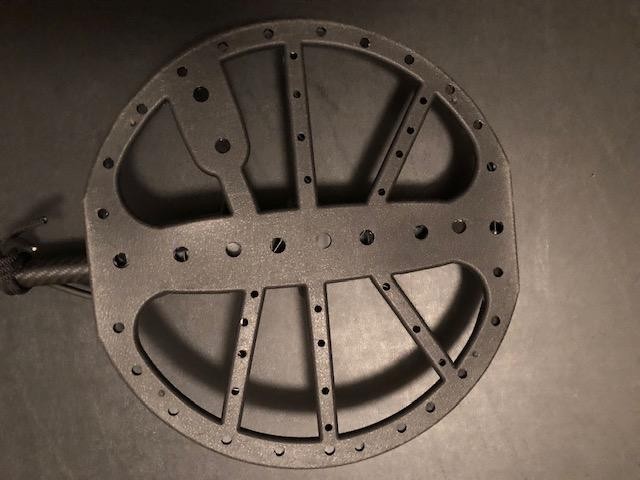-
Posts
595 -
Joined
-
Last visited
Content Type
Forums
Detector Prospector Home
Detector Database
Downloads
Posts posted by ColonelDan
-
-
4 hours ago, Chase Goldman said:
T
Dan, I think you've made that abundantly clear. However, by quoting my several weeks old post without the quote I was originally referring to and that was contained in my original post to a specific poster's claim that "everyone" was missing his point and his "fear" that the cover would not drain effectively, you lost the context and meaning of my post. Note that I was asking a question of the subject "quoted" poster trying to pin down their position on drain holes and their implied stance that direct sealing the coil was not only superior to using drain holes but that drain holes were detrimental to performance for the reasons he stated (i.e., his fear of insufficient draining). I was not making a claim or statement directly to you or others using drain holes for or against drain holes (IMO - they appear to be very effective based on the number of folks successfully using them) but merely was, in my question, noting the irony in his claim given that several folks, including you, posted how drain holes provided a benefit to keeping the coil clean and that none of you were reporting having issues salt water detecting using the altered coil covers. In other words no one seemed to be having any problems with the altered covers draining effectively as was his claim/fear. The question was never addressed with a direct reply btw....?
Chase, Got it. Thanks for the clarification. ?
Soldier on ......
-
On 6/8/2019 at 6:36 AM, Chase Goldman said:
Thanks for explaining it. So you are saying, everyone who is using drain holes in covers are setting themselves up for a performance degradation in the water. That's not good! I wonder why so many do it that way, then?
I’ve been hunting in water and sand with drain holes in my coil cover for many years and have never experienced performance degradation in the least but as I always say, that’s just the view from my foxhole.
-
Congratulations! A perfect illustration as to why I never notch out anything and hunt in all metal on our Florida beaches. ?
-
16 hours ago, RayfromAK said:
No. But pure RTV silicone is not affected by fresh nor salt water. The areas you are bonding with it must be clean and dry, just like when using it to seal the corners of tiled-showers. Long ago I used a Teknetics detector along the ocean beach when living in CA, and never had trouble with the RTV silicone I used.
A final note: I don't see any trouble at all by having drain holes on the coil cover as long as one detects in the water, simply because the coils is being rinsed constantly.
Constant draining is indeed the key to this set up. But I also use this in the dry sand. I normally hunt east to west and when I get near the water on that east/ west path, the water quickly flushes out the sand. This method and set up has been very successful for me but as I always say, it's just the view from my foxhole....?
-
3 hours ago, dewcon4414 said:
Two tone works well, but im not a fan of the 25 setting..... at least not for my ears. Some where around 13 seems to catch me...... and for some odd reason on say a quarter or a can...... it doesnt quit size the target properly being that high. Another consideration is ...... if you are looking for gold.....id go with a disc pattern. A whole lot less targets to check in two tones. Once that box is under....... you are looking for a target first and for most. Patterns can be a great time saver if you know what you want to find. Choosing two tones you have to realize ..... any falsing will come in both those tones. Thats why i like AM and multi tones..... it has a tenancy to move iron back to the iron range. As far as why not single tone........ if you go that way you best be using disc because i can tell you there is a lot of iron out there even when nothing else is........ got to love bobbie pins and bottle caps.
I'll be staying with my custom 3 tones set up. And to each his own RE: pitch. I like 1,12 and 25.
I just posted this 2 tone post as an item of interest based on those videos and how various targets span the spectrum of VDI.
-
In a previous post of mine, I made the case for using 3 tones based on Low, Medium and High conductive targets; a system I routinely use in hunting our Florida beaches. It's simple, effective and gives me the information I really need.
The videos below however, make a strong case for 2 tones and the "Dig it All" approach when using the Equinox series detectors. Why? As you'll see in those videos, the tested targets span the VDI spectrum based on metallurgical composition, shape and size. Granted, these are nothing more than air tests which aren't affected by depth, moisture or ground mineralization but they at least provide some indication as to how a variety of targets range the VDI scale based on their individual characteristics.
If using 2 tones, I would personally set the tone breaks at -9 to 0 using tone pitch 1 indicating probable junk and the second tone break at 1 thru 40 using tone pitch 25.
If I were interested only in a more detailed target description, I would lean heavily toward the CTX 3030. However, in the type of beach hunting I do, I favor the Multi IQ, faster processor, enhanced sensitivity and weight of the EQX over the CTX...just my personal preference or as I always say, "Just the view from my foxhole."
https://www.youtube.com/watch?v=SsgspduZA_8
https://www.youtube.com/watch?v=P7345qtsc7s&feature=youtu.be
https://www.youtube.com/watch?v=eMHH5ynSwW0&feature=youtu.be -
17 minutes ago, dewcon4414 said:
I don’t know that the Nox IS as affected like older model machines. Here in Fl of course we don’t have nearly the minerals. Like I said that accusation of sand in the cross arms doesn’t really affect the detector unless it moves separate from the detector.
Granted, our beaches are relatively low in mineralization where I normally hunt. But since all beaches are different, my simple reasoning is this; if sand isn’t supposed to be there, I want it outta there. ?
-
I suggest you start to drill your holes from the inside of the cover. That way there's no ridges left on the inside to impede the flow of water.
Just the view from my foxhole...
-
Here is a photo of how I modified the coil cover on my EQX 800. Works fine for me on our Florida beaches. One swipe in the water and the sand flushes out.

-
5 minutes ago, FloridaSon said:
Tanks Col,
did you drill similar sized holes as the OP?
I drilled a series of larger holes on the wider areas of the cover and numerous small holes around the narrow rim area.
-
Deep 1, I've been drilling numerous holes in my coil cover for years and, like you said, it works fine and the coil itself is still protected.
After years of hunting the beaches, I found that with a solid coil cover, no matter how well you try and seal them, salt water and sand gets in there. The real problem comes from the indisputable fact that once in there, the sand has no way to get out thus the problem. After I drilled holes in the cover, the water flushes out the sand and I'm good to go.
When I get home and remove the coil cover, I find there's only a few isolated grains of sand left...not nearly enough to cause any problems whatsoever.
-
Super!!!!
Soldier on....
-
Agree with Steve's note from ML. 99% of my hunting is on Florida beaches and the GB works as ML rep states...Beach mode is not locked on 0.
Just the view from my sandy foxhole! ?
-
21 hours ago, Steve Herschbach said:
This is not a rod I would use on the beach for the very reason you mention. These shafts use orings to snug the cam locks and sand in them from constant beach use would not be a good idea.
Thanks....that's exactly what I thought of this design so I'll have to pass. Now were I a land hunter and a backpacker...yes, by all means I'd have one.
-
Steve, That's a great modification and I just might be right behind you as customer #2 when and if that becomes available in the States.
The only real concern for my situation is how sand from our beaches might affect the operation of the telescoping shafts and the locks over time. No matter how careful one is and how precautionary you think you've been, beach sand gets on and into everything.
Thanks for the post...
-
Our beaches along the east coast have been heavily replenished and coupled with no significant nor’easters, finds from the 1715 fleet have been rare as hens teeth.
When conditions improve, the EQX will do just fine!!!
Having said that, come on down and give it a go.
-
Great report on a great adventure! Enjoyed every sentence Steve...thank you.
Soldier on....
-
I previously posted my experience at Key Largo Florida this past summer when I was detecting on a very hot beach and had a cover over the EQX control box. After about an hour, the EQX started to malfunction...buttons and screen.
After removing the cover and letting the EQX cool down, all returned to normal.
-
On 10/4/2018 at 7:28 AM, Alluminati said:
I agree with your view from the foxhole lol.
The only slight tweak I might make is to lower the tone break for med/high from 19/20 to 18/19. This would just keep small silver coins (half dime etc.) and all the pennies in the high tone. Gives a bit more of a buffer for a sloppy swing etc.
I can see the merit in adjusting the mid level zone from a high of 19 down to 18 with the high zone set at 19 and above instead of 20 and above.
Good call Alluminati...I just might have to give that a shot.?
-
My first machine was a Jetco Mustang (1970) and yes, it made you dig it all. Beep and dig...absolutely no discrimination capability. It had one knob...on/off and volume.
-
His initial comment was an indicator, for me at least, as to what this review would be;
" do not try to open the detector control box. Having spent 15 minutes attempting to uncover my machine, I completely destroyed the housing."
My question: Why in the world would any user even want or need to open the control box? Am I surprised that he destroyed the housing? No. What am I missing here?
Just the confused view from my foxhole...?
-
Forgot to mention...not only does gold show up anywhere along the 1-19 scale, I have seen times where it also rang up higher...in the low 20's for example so I dig a lot as you can imagine. It all depends on metallurgical composition, soil conditions, depth etc. So if you're looking for gold, be prepared to dig for it. ?
-
On 10/11/2018 at 2:04 PM, Andy2640 said:
"Just the view from my foxhole"... Your view is a good one from that fox hole....and appreciated. Does the gold you found vary on the VDI, As in skip from say a 12 to 14?
Yes, depending on soil/sand composition, depth and orientation of the target.
I personally dig everything in that range. Do I dig a lot of aluminum? Yes, but I’d rather do that than pass up gold in an attempt to second guess myself.
Now if the tone and VDI jump around erratically, I can bet it’s a bottle cap. But that’s just my experience along our beaches where I do 99% of my detecting.
Good luck...
-
Now this is just from my testing and experience on our Florida beaches...your mileage may vary as I always say.
Gold, being a mid level conductor, I've found ranges anywhere from 1 -18/19 on the Equinox. Small chains have been detected at 1,2,and 3 while larger gold objects range higher depending on the K. Of course the soil composition also impacts the VDI. Having said all that, aluminum also rings up in the 1-19 range so you'll be digging junk too but that's the price we pay if we want to focus in on gold.
Just the view from my foxhole...



Tom Dankowski Tips For Low Mineral Ground
in Minelab Equinox Forum
Posted
Great thread Steve....thank you